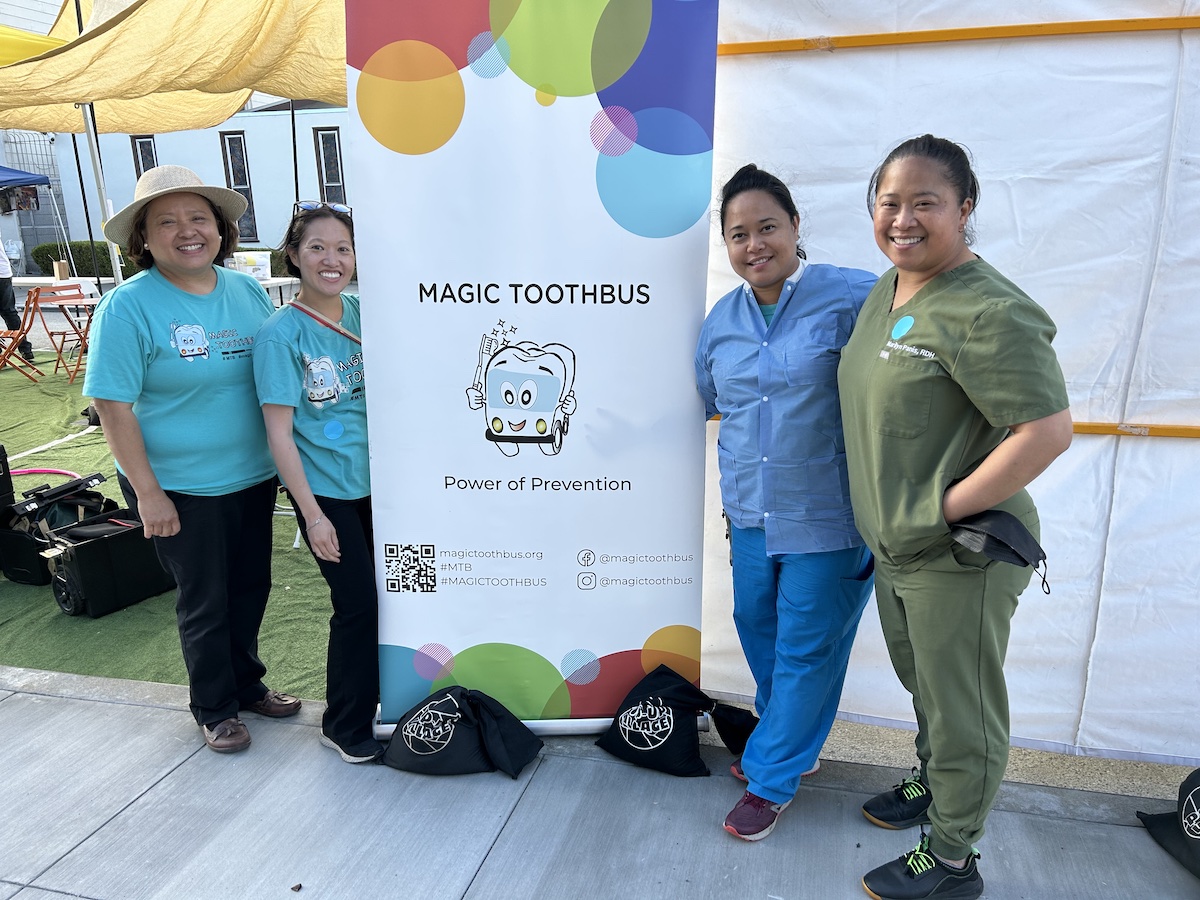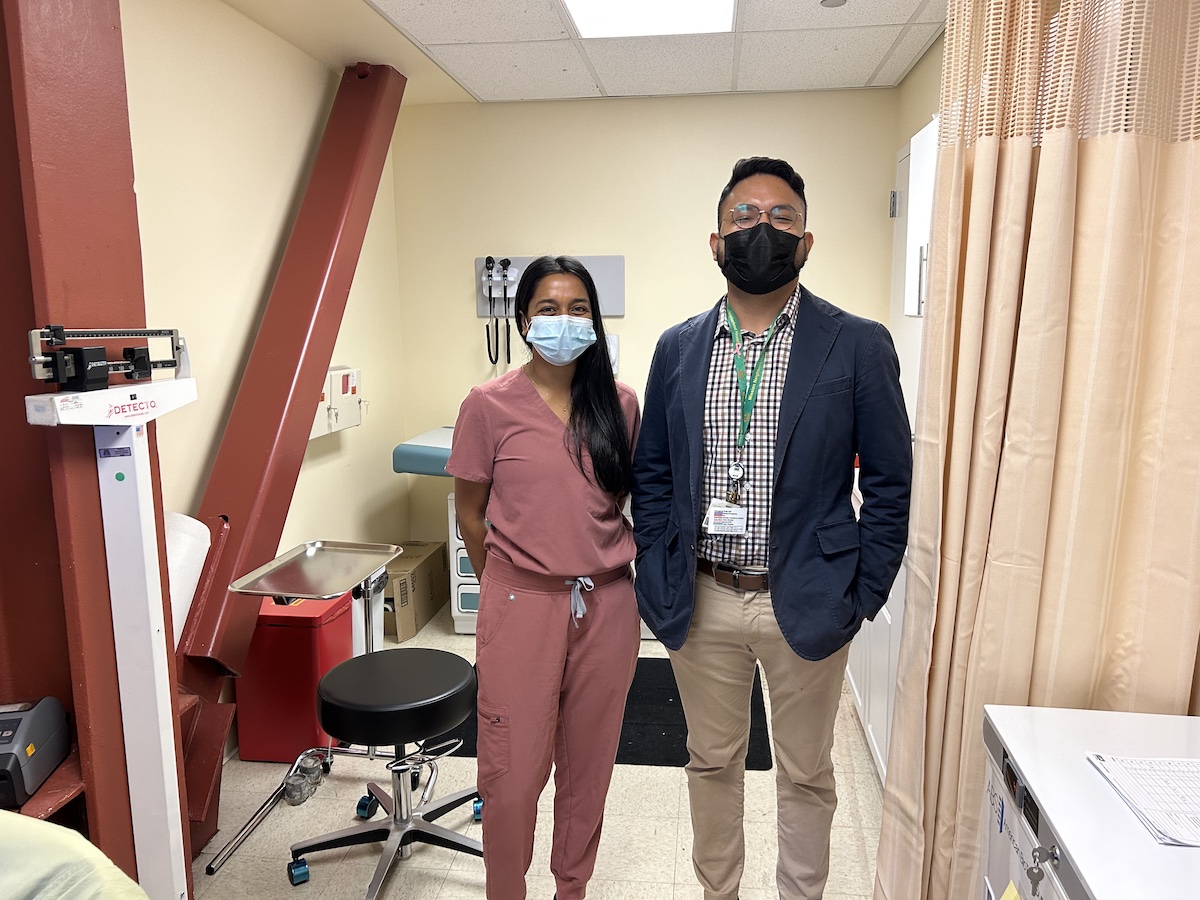With Halloween in full force tonight, parents of candy-hungry kiddos may want to brush up on the horrors of tooth decay — especially those with children in the Mission.
Kids in the city’s southeast are more at risk for cavities than those in other neighborhoods, according to data from the San Francisco Department of Public Health.
That led Mylene Deano, a registered dental assistant at the South of Market Health Center, and her colleagues Seraphine Xieu and Andrea Almario to try something new: A “Magic ToothBus” mobile dental clinic that goes to schools, events, and community health fairs across Oakland, San Francisco, and other parts of the Bay, hoping to sign children up for screenings and dental referrals.
Across from the Bayview Opera House on a recent weekend, members of the Magic ToothBus were armed with a giant toy toothbrush and a grinning stuffed shark, alongside dental kits. A young girl sat in the leather chair while a hygienist checked her teeth in a big mirror.
“Some of the parents cannot bring their kids, because they have two jobs,” Deano said, adding that, years ago, she noticed children skipping dental appointments — even those scheduled on a Saturday. Other times, “they really don’t know the coverage of their insurance,” or have trouble navigating Medi-Cal.
“We wanted to give an alternative solution,” Deano said.
Since 2000, when the health department started screening kindergarteners for tooth decay, children living in the Mission, Chinatown, Excelsior and Bayview have reported higher rates of decay, which destroys teeth and can cause cavities. Additionally, Latinx, Asian and Black kindergarteners consistently report higher rates of decay than white kindergarteners.
As of the 2021-22 school year, 43 percent of the school district’s Latinx kindergarteners screened reported evidence of tooth decay compared to 14 percent of white children. Meanwhile, 38 percent of Asian kindergarteners and 37 percent of Black kindergarteners reported evidence of tooth decay.

Kindergartners at lower-income schools have more cavities
= percentage with cavities
= percentage without cavities
23%
17%
39%
44%
High-income
Middle-high income
Middle-low income
Low-income

Kindergartners at lower-income
schools have more cavities
= percentage with cavities
= percentage without cavities
23%
17%
High-income
Middle-high income
39%
44%
Middle-low income
Low-income
Source: San Francisco Department of Public Health, for the 2017-18 academic year. Chart by Kelly Waldron.
One major reason is not going to or having a dentist, some experts suggest, so Deano and co-workers Xieu and Almario, among others, launched the Magic ToothBus in 2018.
The nonprofit began by presenting dental lessons to kids at five at-risk schools in 2018, and in 2019, it received a grant to expand to a full-fledged mobile bus for screenings and referrals.
The team soon realized there were a litany of reasons why a child could go without dental care: Parents choosing healthcare instead of dental care when on a tight budget, for instance, or language barriers.
The same environmental conditions that create high rates of diabetes and hypertension can cause poor dental hygiene, said Dr. Irene Hilton, a dentist at the San Francisco Health Network who helped launch the kindergarten screening program: “The social determinants of health.”
The latter is a concept in public health that suggests environmental factors, such as income, culture and housing may make some populations more at risk for a disease than others. For example, Latinx people in San Francisco were more likely to be infected with Covid-19 than white residents, because they tended to work in riskier public-facing jobs, or live in overcrowded housing. Covid-19 also hit the southeast neighborhoods hardest early in the pandemic.
Geography and income can cause dental disparities, too. Per 2017-2018 data, the rates of tooth decay or cavities are almost three times higher among kindergarteners at schools in low-income areas, compared to those at schools in high-income areas, a city health report showed. And, while cavities among children have decreased in the past decade, most of the gains have mostly been among schools in high-income areas.
Typically, members like Deano park the Magic ToothBus at school or community events to educate passersby about proper dental hygiene, and sometimes open a dental screening and referral station.
Those most interested are monolingual Chinese or Spanish-speakers, Deano said. And the mobile unit seems to be reaching its target population: A few weeks ago at the Children’s Council Healthy Kids Fair, some 50 families, most of them Latinx, stopped by the fair for screenings and referrals. “We saw probably six to seven kids who haven’t seen a dentist,” Deano said.
Deano and Hilton agreed that waiting to see a dentist has consequences.
“The biggest factor for having cavities as an adult is having them as a kid,” Hilton said. Once a permanent tooth is lost, it can be replaced by an implant or dentures, if at all.
The Magic ToothBus is just one part of the solution. The nonprofit partners with the health department’s CavityFreeSF campaign, an initiative to improve oral health among San Francisco children. Extra funds from the Sugary Drinks Tax funded local “oral task forces,” or community nonprofits tasked with monitoring dental problems in the Bayview, Chinatown and Mission.
The school district has also ramped up resources. The health department screens students at certain transitional preschools and provides cavity sealants to second and fifth graders in some 30 schools, said Dr. Hilton.
When it comes to oral health, it’s best to start when they’re younger, Deano said. “The first five years of the children’s life is very critical.”




